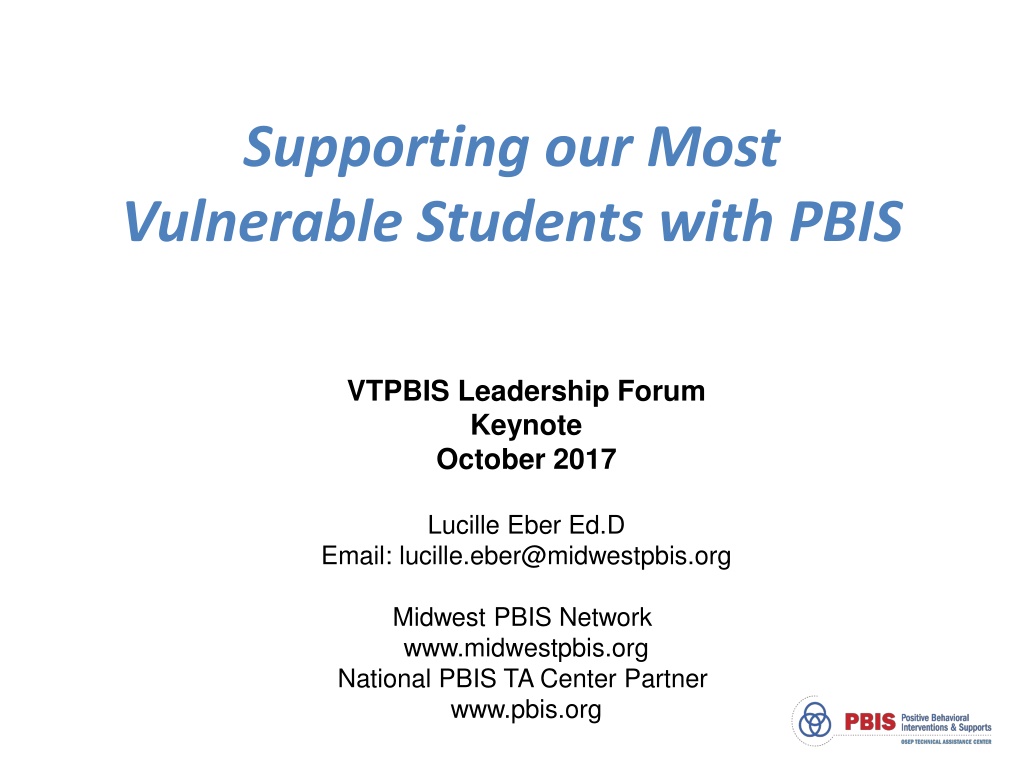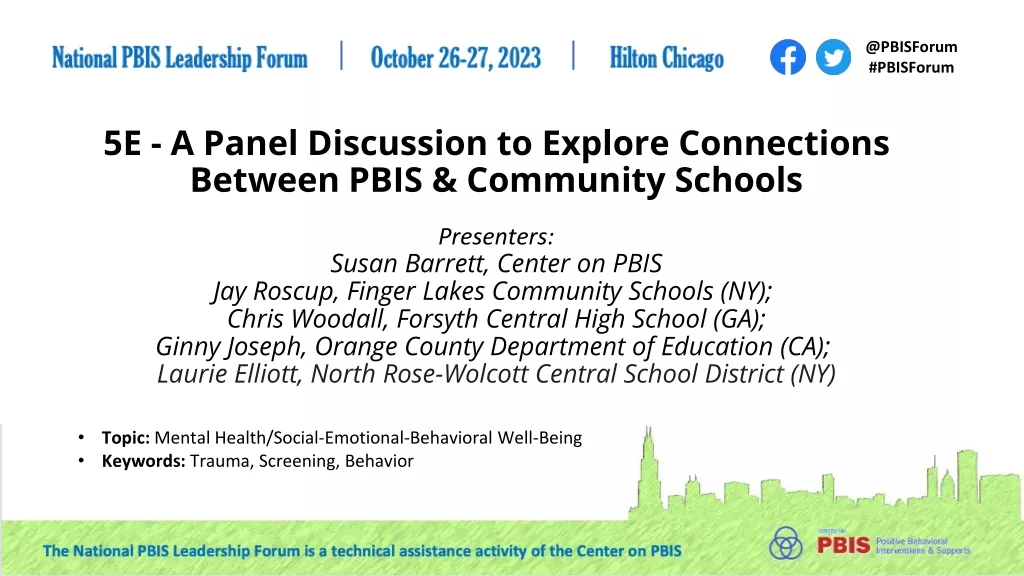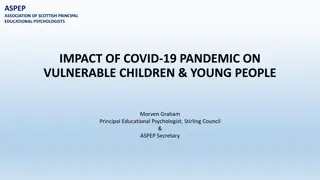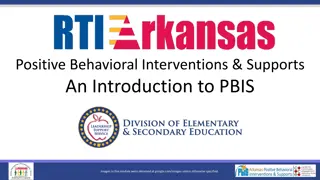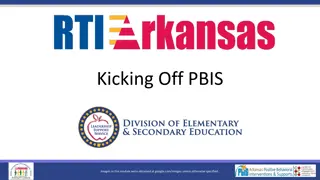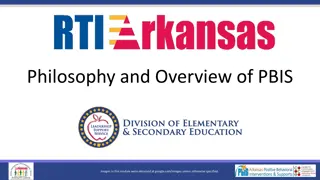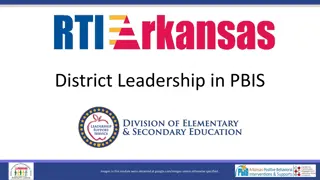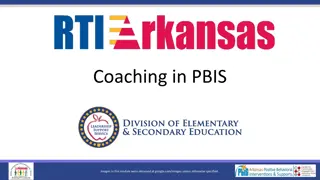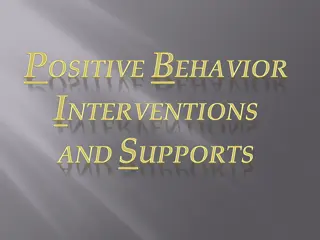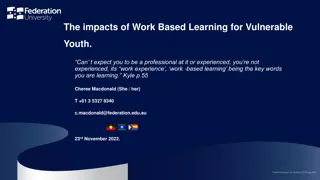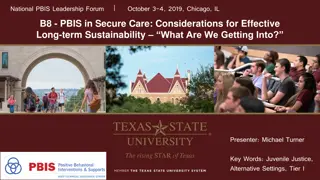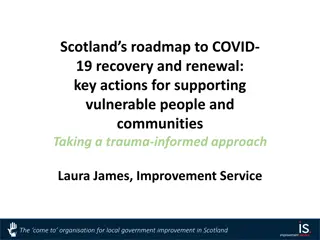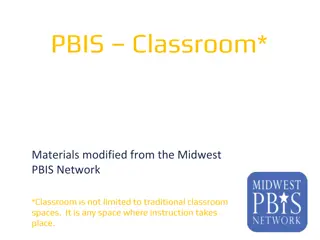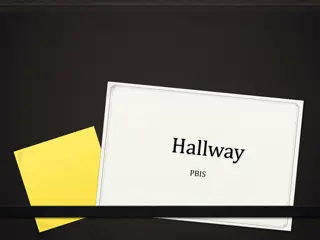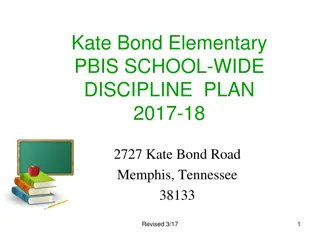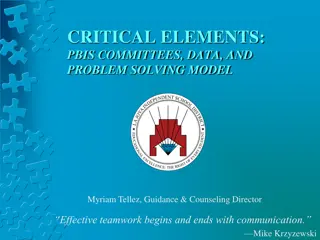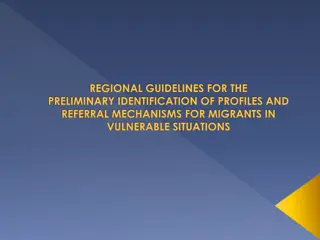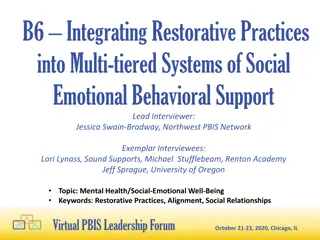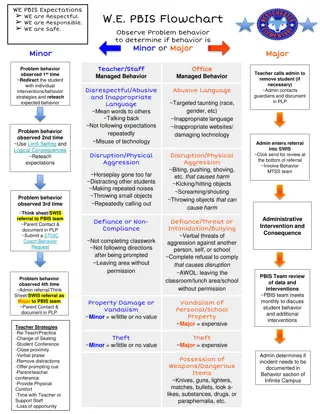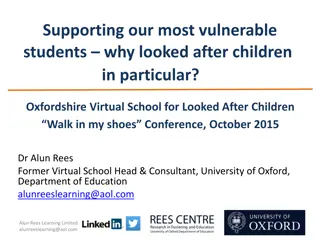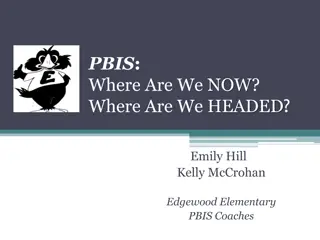Supporting Vulnerable Students with PBIS: Key Strategies
Effective support for students with intensive behavior, mental health, or academic needs requires a strong foundational system. This session focuses on the key features of a multi-tiered system to ensure accurate and effective interventions for students with complex needs within a school-wide PBIS framework. Addressing common confusions and misconceptions around intervention effectiveness, the session emphasizes the importance of allocating resources commensurate with student needs. Strategies for implementing impactful interventions and avoiding restrictive placements are highlighted, with a call to prioritize school climate and safety as integral indicators of academic achievement under the Every Student Succeeds Act.
Download Presentation

Please find below an Image/Link to download the presentation.
The content on the website is provided AS IS for your information and personal use only. It may not be sold, licensed, or shared on other websites without obtaining consent from the author. Download presentation by click this link. If you encounter any issues during the download, it is possible that the publisher has removed the file from their server.
E N D
Presentation Transcript
Supporting our Most Vulnerable Students with PBIS VTPBIS Leadership Forum Keynote October 2017 Lucille Eber Ed.D Email: lucille.eber@midwestpbis.org Midwest PBIS Network www.midwestpbis.org National PBIS TA Center Partner www.pbis.org
Session Description Supporting students with intensive behavior/mental health/academic needs requires strong foundational systems. This session will share multi-tiered system features needed to ensure effective interventions are implemented accurately and effectively. Descriptions and examples of interventions for students with complex needs within a school-wide system of PBIS will be shared.
Your Opportunities to Respond 1. A BIG idea I get and can maybe share? 2. A BIG idea I am still circling ? 3. A BIG idea I can take back and we can DO?
Confusion about what constitutes effective support? Exclusion (or placements) seen as intervention Confuse label as intervention Confuse paperwork with intervention Confuse people with interventions Not so great interventions Not so great fidelity Resources not allocated commensurate with needs
Did Henry need a restrictive placement?
Henrys Daily Point Data for Behavioral Goals 100 80 % of Goal Achieved 60 40 20 0 9/3 9/10 9/17 9/24 10/1 10/8 %of Daily Total CICO Points
Did Henry need a restrictive placement? Or effective interventions?
Every Student Succeeds Act Why School Climate Should Be One of Your Indicators Read the Center for Positive Behavioral Interventions and Supports Technical Brief www.pbis.org/training/technical-guide
Every Student Succeeds Act Why School Climate Should Be One of Your Indicators What is the purpose? An important emphasis of ESSA is school climate and safety, which are integrally linked to academic achievement, active student and teacher engagement, and tiered systems of support for all students; but especially our most vulnerable students (e.g., students with disabilities English language learners, students from disadvantaged and diverse backgrounds and environments).
Every Student Succeeds Act Why School Climate Should Be One of Your Indicators What is school climate? Generally, school climate represents the shared norms, beliefs, attitudes, experiences, and behaviors that shape interactions between and among students, teachers, and administrators. www.pbis.org/training/technical-guide
Every Student Succeeds Act Why School Climate Should Be One of Your Indicators Organizing/Aligning School Climate: Rather than addressing each behavior issue Bullying behaviors, tardiness, aggressive acts, substance abuse, trauma exposure or climate condition Safety, respect, discrimination, mental health, civility Restorative practices, classroom bully-proofing, character education, life skills training, trauma informed care as separate initiatives related interventions, practices, personnel and programs School mental health, special education, nursing, school psychology and counseling must be organized around common need or outcome. Resource at www.pbis.org: Technical Guide for Alignment of Initiatives, Programs, Practices in School Districts
Advantages of PBIS/MTSS Framework Promotes effective decision making Improves climate & learning environment Changes adult behavior Reduces punitive approaches Reduces OSS and ODRs Improves student academic performance
Experimental Research on SWPBIS Bradshaw, C.P., Koth, C.W., Thornton, L.A., & Leaf, P.J. (2009). Altering school climate through school-wide Positive Behavioral Interventions and Supports: Findings from a group-randomized effectiveness trial. Prevention Science, 10(2), 100-115 Bradshaw, C.P., Koth, C.W., Bevans, K.B., Ialongo, N., & Leaf, P.J. (2008). The impact of school-wide Positive Behavioral Interventions and Supports (PBIS) on the organizational health of elementary schools. School Psychology Quarterly, 23(4), 462-473. Bradshaw, C. P., Mitchell, M. M., & Leaf, P. J. (2010). Examining the effects of School-Wide Positive Behavioral Interventions and Supports on student outcomes: Results from a randomized controlled effectiveness trial in elementary schools. Journal of Positive Behavior Interventions, 12, 133-148. Bradshaw, C.P., Reinke, W. M., Brown, L. D., Bevans, K.B., & Leaf, P.J. (2008). Implementation of school-wide Positive Behavioral Interventions and Supports (PBIS) in elementary schools: Observations from a randomized trial. Education & Treatment of Children, 31, 1-26. Bradshaw, C., Waasdorp, T., Leaf. P., (2012 )Effects of School-wide positive behavioral interventions and supports on child behavior problems and adjustment. Pediatrics, 130(5) 1136-1145. Horner, R., Sugai, G., Smolkowski, K., Eber, L., Nakasato, J., Todd, A., & Esperanza, J., (2009). A randomized, wait-list controlled effectiveness trial assessing school-wide positive behavior support in elementary schools. Journal of Positive Behavior Interventions, 11, 133-145. Horner, R. H., Sugai, G., & Anderson, C. M. (2010). Examining the evidence base for school-wide positive behavior support. Focus on Exceptionality, 42(8), 1-14. Ross, S. W., Endrulat, N. R., & Horner, R. H. (2012). Adult outcomes of school-wide positive behavior support. Journal of Positive Behavioral Interventions. 14(2) 118-128. Waasdorp, T., Bradshaw, C., & Leaf , P., (2012) The Impact of Schoolwide Positive Behavioral Interventions and Supports on Bullying and Peer Rejection: A Randomized Controlled Effectiveness Trial.Archive of Pediatric Adolescent Medicine. 2012;166(2):149-156 Bradshaw, C. P., Pas, E. T., Goldweber, A., Rosenberg, M., & Leaf, P. (2012). Integrating schoolwide Positive Behavioral Interventions and Supports with tier 2 coaching to student support teams: The PBISplus Model. Advances in School Mental Health Promotion, 5(3), 177-193. doi:10.1080/1754730x.2012.707429 Freeman, J., Simonsen, B., McCoach D.B., Sugai, G., Lombardi, A., & Horner, ( submitted) Implementation Effects of School-wide Positive Behavior Interventions and Supports on Academic, Attendance, and Behavior Outcomes in High Schools.
We know the practices that work for students with significant mental needs Proactive, strength-based; set kids up to experience success High rates of consistent, supported instruction; teach/practice/reinforce Predictable and consistent environments Know unique why? for each student/problem Contextual fit: Strategic use of natural supports, and settings Careful monitoring of data over time with ongoing revisions to guide incremental improvements in quality of life
It Takes a System that builds system capacity for advanced tiers
Social Competence & Academic Achievement Positive Behavior Support OUTCOMES Supporting Decision Making Supporting Staff Behavior PRACTICES Adapted from What is a systems Approach in school-wide PBS? OSEP Technical Assistance on Positive Behavioral Interventions and Supports. Accessed at http://www.Pbis.org/schoolwide.htm Supporting Student Behavior
EBP = Teaching Skills (same for social/emotional as for academics) Define simply Based on data, adjust instruction & reteach Model/demonstrate w/ range of examples Monitor & provide positive feedback & reinforcement Practice in range of natural settings
Core features of MTSS framework: Teams Data-based decision making Continuum of linked EBPs Screening Progress monitoring Ongoing PD/coaching Are these features in place (or partially/in progress) in your district?
Tertiary Prevention: Specialized Individualized Systems for Students with High-Risk Behavior SCHOOL-WIDE POSITIVE BEHAVIOR SUPPORT ~5% Secondary Prevention: Specialized Group Systems for Students with At-Risk Behavior ~15% Primary Prevention: School-/Classroom- Wide Systems for All Students, Staff, & Settings ~80% of Students
Consider features of SWPBIS w/regards to youth with significant social/emotional needs Module 1: PBIS Team Module 2: Faculty Commitment Module 3: Expectations and Rules Module 4: Lesson Plans Module 5: Acknowledgement Module 6: Discipline Procedures Module 7: Data Entry and Analysis Module 8: Classroom Behavior Systems Module 9: Evaluation Module 10: Implementation Plan
How Can We Differentiate Instruction? ALL Means ALL! Kick-off events Teaching staff, students, and families the expectations and rules On-going direct instruction Data-driven and scheduled designed lessons Pre-correction Re-teaching immediately after behavioral errors Embedding into curriculum Booster trainings Scheduled and data-driven More Visual Cues? Extra Practice/Rehearsal? Peer supports? Buddies? Peer Leaders? Other? (think: Same as academics!) Continued visibility Visual displays posters, agenda covers Daily announcements Newsletters
Tier I Acknowledgements Guidelines School-wide reinforcements are for every student Acknowledge the behavior Include ALLstudentsin identifying possible recognitions Recognize students other than your own in common areas Recognition closely follows the desired behavior Keep it novel Effective & Efficient
Why arent we doing it? What do we know from the empirical literature? Teachers typically receive little pre- or in-service training in classroom management Begeny & Martens, 2006; Freeman, Simonsen, Briere, & MacSuga, in press; Markow, Moessner, & Horowitz, 2006; Special Education Elementary Longitudinal Study, 2001, 2002, 2004; Wei, Darling-Hammond, & Adomson, 2010) Multi-component training packages (didactic training + coaching + performance feedback + etc.) result in desired behavior change, especially when trained skills are effective Abbott et al., 1998; Hiralall & Martens, 1998; Madsen, Becker, & Thomas, 1968; Freeman et al., in preparation; The Metropolitan Area Child Study Research Group & Gorman-Smith, 2003; Rollins et al., 1974 (Simonsen, B., PBIS Conference Keynote, 2016)
8 Positive Behavioral Classroom Supports Tier 1 Integrates Positive Behavioral Classroom Supports 1. Arrange orderly physical environment 2. Define, Teach, Acknowledge Rules and Expectations (T1 Modules 1.3, 1.4, 1.9) 3. Define, Teach Classroom Routines (T1 Modules 1.3, 1.4) 4. Employ Active Supervision 5. Provide Specific Praise for Behavior (T1 Module 1.9) 6. Continuum of Response Strategies for Inappropriate Behaviors (T1 Module 1.5-1.6) 7. Class-Wide Group Contingency 8. Provide Multiple Opportunities to Respond Adapted from MO Classroom PBIS
INCORPORATE Coping Strategies for Managing Stress Teaching Matrix Library/ Comput er Lab All Lunch Halls Playgrounds Assembly Bus Settings Be on task. Give your best effort. Be prepared. Study, read, compute. Sit in one spot. Watch for your stop. Respectful Walk. Have a plan. Invite those sitting alone to join in Have a lunch plan and choose quiet or social lunch area Share equipment. Include others. Expectations Use normal voice volume. Walk to right. Be kind. Hands/feet to self. Help/share with others. Listen/watc h. Use appropriate applause. Use a quiet voice. Stay in your seat. Achieving & Organized Whisper. Return books. Invite friends to join me Use my breathing technique Pick up litter. Maintain physical space. Push in chairs. Treat books carefully. Use equipment properly. Put litter in garbage can. Recycle. Clean up after self. Pick up. Treat chairs carefully. Wipe your feet. Responsible Listen to my signals
Data Highlights 2015-16 Annual Report Decrease in suspensions in every group Significant decrease in suspensions for Black students and Students with Disabilities Outcomes for ALL
Schools at fidelity/full implementation for the last 2-3 years have seen a GREATER DECREASE in suspension rates for STUDENTS WITH DISABILITIES than the state and schools with no record of implementing. Students with Disabilities Suspension 16.00% 14.00% 12.00% 10.00% 8.00% 6.00% 4.00% 2.00% 0.00% 2009-2010 2015-2016 State Behavior Reading B+R Outcomes for ALL
MAP Proficiency by SW-PBIS Implementation Levels - All Students 60.0% 58.0% 56.0% 54.0% 52.0% 50.0% 48.0% 46.0% 44.0% Comm Arts Math Comm Math Comm Math Comm Math Comm Math Comm Math Comm Math Arts Arts Arts Arts Arts Arts Preparation Emerging Bronze Silver Gold non SW-PBS All Schools 2010 2011
MAP Proficiency by SW-PBIS Implementation Levels - IEP Students 50.0% 45.0% 40.0% 35.0% 30.0% 25.0% 20.0% Comm Arts Math Comm Arts Math Comm Arts Math Comm Arts Math Comm Arts Math Comm Arts Math Comm Arts Math Preparation Emerging Bronze Silver Gold non SW-PBS All Schools 2010 2011
A Multi-tiered Continuum of Behavioral Support Tier 1/Universal School-Wide Assessment School-Wide Prevention Systems ODRs,Credits, Attendance, Tardies, Grades, DIBELS, etc. Tier 2/ Secondary Check-in Check-out (CICO) Social/Academic InstructionalGroups (SAIG) Daily Progress Report (DPR) (Behavior and Academic Goals) Group Intervention with Individualized Feature Tier 3/ Tertiary Competing Behavior Pathway, Functional Assessment Interview, Scatter Plots, etc. Brief Functional Behavior Assessment/ Behavior Intervention Planning(FBA/BIP) Individual Student Information System (ISIS) Complex or Multiple-domain FBA/BIP SIMEO Tools: HSC-T, RD-T, EI-T USDOE-OSEP Tertiary Demo Project Wraparound #H326M0060010
Tier 2/Tier 3 Changing Existing Systems Harder than starting from scratch Schools think they are already doing it Need to deconstruct some existing teaming approaches and practices Data not being used except to justify placements
Examples of Ineffective Secondary/Tertiary Structures Referrals to Sp. Ed. seen as the intervention FBA seen as required paperwork vs. a needed part of designing an intervention Interventions the system is familiar with vs. ones likely to produce an effect (ex: student sent for insight-based counseling at point of misbehavior)
IL Tertiary Demo School Reduces ODRs & Increases Simple Secondary Interventions 40 36 35 number of students 30 25 20 15 10 5 5 5 1 0 Aug to Nov 2006 Aug to Nov 2007 2-5 ODRs 6+ ODRs CICO* *CICO = Check in, Check Out
Example of change that may be needed Groups that are not evidence-based Clinicians seeing students w/o clarity of intervention and data to determine effectiveness Re-install FBA/BIP process with focus on effectiveness vs compliance
Social Skills/Academic Instructional Groups: Selection into groups based on youths reaction to life circumstance not existence of life circumstances ex. fighting with peers, not family divorce Goals for improvement common across youth in same group ex. use your words Data used to measure if skills are being USED in natural settings (vs. in counseling sessions) transference of skills to classroom, caf etc. Stakeholders (teachers, family etc.) have input into success of intervention ex. Daily Progress Report
Daily Progress Report (DPR) Sample NAME:______________________ DATE:__________________ Teachers please indicate YES (2), SO-SO (1), or NO (0) regarding the student s achievement in relation to the following sets of expectations/behaviors. 1st block 2nd block 3rd block 4th block EXPECTATIONS 2 1 0 2 1 0 2 1 0 2 1 0 Be Safe 2 1 0 2 1 0 2 1 0 2 1 0 Be Respectful 2 1 0 2 1 0 2 1 0 2 1 0 Be Responsible Total Points Teacher Initials Adapted from Grant Middle School STAR CLUB
Daily Progress Report (DPR) Sample Trauma-Informed Tier 2 Group NAME:______________________ DATE:__________________ Teachers please indicate YES (2), SO-SO (1), or NO (0) regarding the student s achievement in relation to the following sets of expectations/behaviors. 1st block 2nd block 3rd block 4th block EXPECTATIONS 2 1 0 2 1 0 2 1 0 2 1 0 Be Safe Self-Check Use calming strategy 2 1 0 2 1 0 2 1 0 2 1 0 Be Respectful Use your words Use safe hands 2 1 0 2 1 0 2 1 0 2 1 0 Be Responsible Ask for help Connect with safe person Total Points Teacher Initials Adapted from Grant Middle School STAR CLUB
Daily Progress Report (DPR) Sample Tier 3 Plan with Trauma-Informed Strategy NAME:______________________ DATE:__________________ Teachers please indicate YES (2), SO-SO (1), or NO (0) regarding the student s achievement in relation to the following sets of expectations/behaviors. 1st block 2nd block 3rd block 4th block EXPECTATIONS 2 1 0 2 1 0 2 1 0 2 1 0 Be Safe SOS (slow down, orient, self-check) Use mindfulness 2 1 0 2 1 0 2 1 0 2 1 0 Be Respectful Distract & Self- Soothe Let M Go 2 1 0 2 1 0 2 1 0 2 1 0 Be Responsible Make A Link Make Meaning Total Points Teacher Initials Adapted from Grant Middle School STAR CLUB
Individualized Student Card (FBA/BIP) Daily Progress Report (DPR) Sample NAME:______________________ DATE:__________________ Teachers please indicate YES (2), SO-SO (1), or NO (0) regarding the student s achievement in relation to the following sets of expectations/behaviors. 1st block 2nd block 3rd block 4th block EXPECTATIONS 2 1 0 2 1 0 2 1 0 2 1 0 Be Safe Use your words Use deep breathing 2 1 0 2 1 0 2 1 0 2 1 0 Be Respectful Keep arm s distance Use #2 voice level when upset 2 1 0 2 1 0 2 1 0 2 1 0 Be Responsible Ask for breaks Self-monitor with DPR Total Points Teacher Initials Adapted from Grant Middle School STAR CLUB
We know the practices that work Proactive, strength-based; set kids up to experience success High rates of consistent, supported instruction; teach/practice/reinforce Predictable and consistent environments Know unique why? for each student/problem Contextual fit: Strategic use of natural supports, and settings Careful monitoring of data over time with ongoing revisions to guide incremental improvements in quality of life
We Know the System Features Needed to Support the Effective Practices A Team unique to each individual child & family Blend the family/natural supports with the school representatives who know the child best A defined Meeting Process Meet frequently and use data Develop, implement, review range of interventions Facilitator Role Bringing team together Blending perspectives; guiding consensus Systematic use of data (strengths and needs)
Behavior support is the redesign of environments, not the redesign of individuals. Positive behavior support plans define changes in the behavior of those who will implement the plan. A behavior support plan describes what we will do differently. Do ALL staff understand the context for effective behavior interventions?
Interventions Ownership & Voice: A Key to Intervention Design The person who is supposed to implement the strategy needs to be actively involved in designing it, or it probably won t work!
Tier 3 Interventions Person-centered (voice and choice) Highly individualized (unique team per student) Multiple data sources (add Tier 3 data - Perception data) Complex function-based behavior plans Wraparound/RENEW/Family-Focused Plans
Problem Solving Steps Step 1: Problem Identification What s the problem? Step 4: Response to Intervention Is it working? Step 2: Problem Analysis Why is it occurring? Step 3: Intervention Design What are we going to do about it?
Competing Behavior Pathway Behavior Intervention Plan Setting Event Strategies Antecedent Strategies Teaching/ Instructional Strategies Consequence Strategies Neutralize/ eliminate setting events Add relevant & remove irrelevant triggers Teach alternative that is more efficient Add effective & & remove ineffective reinforcers
Behavioral Pathway Consequence Setting Event Problem Behavior Function Negative comments about activity and to peers leading to physical contact Sent out of P.E. class To escape setting Days with Gym
Brief Function-based Interventions Setting Event Strategies Add check-in before gym Antecedent Strategies Behavior Lessons for all students about using respectful language with self and others and how to be a good sport Teaching Strategies Teach social skills (getting along with others, friendship, problem solving, sportsmanship) Consequence Strategies Acknowledging /rewarding student when uses new skills (asking for a drink of water to leave, using respectful language with peers, being a good sport, etc..) Teach how to approach gym teacher to ask for a drink of water to leave setting. . More frequent activities with less focus on competition (parachute, 4-square, etc...) Teach student how to re-enter and continue with activity Pre-correct
Bens Story September 2014 - CICO started Mid October, 40% November - community-based mentor assigned December - Ben request to return to psych hospital saying, I can t control myself (has had three prior admissions) December 5 - Tier 3 team met. Recommended referral to wraparound based on following: CICO average of 50% 30 Office Disciplinary Referrals 3 Out of School Suspensions At risk for alternative school placement At risk for out-of-home placement December 15 - Wraparound started with Ben and Barb
Family Strengths Example Supportive boyfriend (Rob) Hard worker, employed Stable housing Active w/ Ben cooking, games, videos, Values family concept, Invested in Ben s success Attends all meetings, appointments Strong Christian faith Support from relatives, boyfriend Not afraid to ask for help Open to feedback/good follow up on suggestions Unconditional, loving, commitment Involved in church activities Values education Love & like each other Friendly, kind-hearted Likes to cook gourmet meals Likes math, reading, writing Neat, well-groomed Organized, good w/ detail Attends schools regularly Smart, capable of doing the work Has had academic success Hard worker, reliable, dependable Creative, enjoys drawing cartoons Likes playing video games Likes Rob
